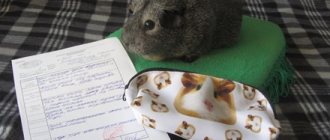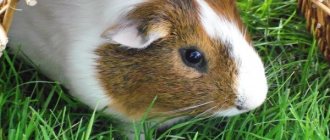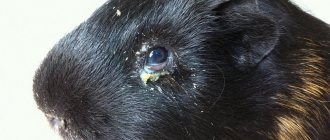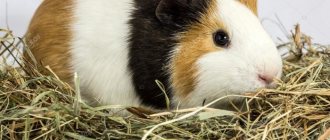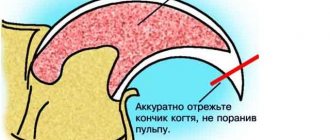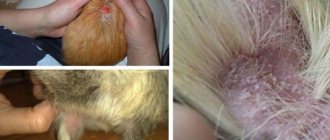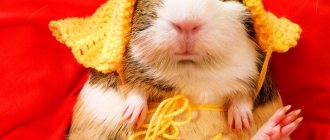Guinea pigs have a strong place among pets. These are sweet, beautiful creatures, devoid of aggression towards family members. Now there are more than one and a half dozen breeds of guinea pigs and selection work continues. Can lice-eaters appear and why in a guinea pig if it lives in a house? We will analyze everything in order in the article, including the solution to this unpleasant issue.
Like all animals, these little ones are susceptible to a number of diseases. But the veterinarians of the Ya-VET Emergency Veterinary Care Center successfully cope with all ailments. If your pig suddenly becomes lethargic
or she shows other signs of the disease, then there is no need to waste time. When treating any disease, the main thing is to start on time.
Contact the Ya-VET Center for Emergency Veterinary Care for Animals, where veterinarians with extensive experience and deep knowledge will successfully conduct research using modern equipment and, having made an accurate diagnosis, prescribe the most effective treatment.
You can call a veterinarian at home by calling. The maximum waiting time is no more than 40 minutes!
Today we propose to understand the question - what are lice eaters in guinea pigs?
, how dangerous this parasite is and what methods of combating it exist today.
Existence and reproduction of lice eaters
The parasite has a flat body. The maximum size of an adult is 2 mm. On dark pig fur it appears white or yellowish, on white fur it appears grey.
When magnifying the lice eater under a microscope, it was discovered that its fur was covered with bristles. The head is large, angular in shape, with eyes, antennae and a rather large mouth. The lice eater's jaws are powerful and covered with teeth. It moves on 6 paws with claws at the end, which additionally causes irritation on the skin of the affected animal.
Static louse multiply quite quickly. The lice beetle can lay more than 100 eggs at a time. The parasite glues them to the fur with a sebaceous substance that it secretes from its gland. The larva grows within 3 weeks.
Worms
Due to the fact that the main property of this group of parasites is to absorb nutrients from the animal’s blood, this can lead to exhaustion. Typically, guinea pigs are inhabited by tape and round parasites. Worm larvae of this type are dangerous not only for the animal, but also for the owner. With severe infection, you can see not only worm larvae in the stool, but also quite adult individuals with the naked eye. The animal is characterized by lethargic behavior, drowsiness and decreased appetite. If the infection is very strong, parasites crawling out of the anus can also be seen with the naked eye.
If the infection is not severe, you can give the animal a suspension of prazicide for kittens. The amount is calculated at the rate of 1 gram per 1 kg of animal weight. Dirofen paste has a good reputation among veterinarians. When treating an animal with medications, you need to treat the cage and accessories with a chlorine-containing solution.
Signs of parasites
Symptoms in an animal do not appear immediately, but then they are expressed in several forms:
- Itching on the skin. The pig begins to constantly itch and bite itself, trying to gnaw out the lice-eaters, without regulating the strength of the bites on the skin. As a result, wounds and abrasions appear.
- Lack of sleep and appetite. The animal becomes restless and stops eating food in normal quantities. As a result, vitamin deficiency and anemia appear, and immunity decreases.
- Hair loss.
- The animal has a sloppy appearance - the fur does not shine and looks greasy.
- The presence of parasites on the fur. When examining the fur closely, worms 1 mm long are visible.
- The tired appearance of an animal at any time of the day, as the constant struggle exhausts him emotionally.
- An allergic reaction is redness of the skin.
Important! Lice eaters are parasites that carry dangerous diseases such as helminthiasis, fungus, viruses and bacteria.
Group of ectoparasites
This type includes skin types of parasites. The most common are skin lice, fleas and lice. The first symptoms of a pet infection include redness and itching of the skin, as well as hair loss in areas where microorganisms accumulate. It is this type of parasite that causes diseases that cause exhaustion, purulent ulcers, and in advanced cases, death. Moreover, the latter scenario can occur not only due to the animal’s lack of appetite, but also due to less obvious signs such as general blood poisoning. The fact is that toxic substances enter the blood through abrasions and microcracks formed by scratching the affected areas by the animal itself.
Reasons for appearance
Static lice are transmitted through direct animal contact. Parasites also settle in sawdust and hay, which are added to the cage when cleaning. They may also appear in food packaging that has not been hermetically sealed.
The maximum risk of infection occurs during the cold season (late autumn and winter), when the animal’s fur becomes thicker and the undercoat grows more actively.
To prevent infection, you need to clean the cage more often and use proven bedding materials.
Lice
Despite the rarer occurrence of this type of parasite, they can occur even with good care of the pet. And, most dangerously, it can be transmitted to humans through contact with a sick animal. Lice cause the appearance of pediculosis, which is characterized by severe itching, obesity and increased temperature of the animal. Lice can be treated using fairly gentle methods: if the infestation is not so local, you can use specialized shampoos. Veterinarians recommend treating the animal with a 10-day course of ivarmectin just in case. The pig's cage must be washed with a solution containing chlorine. It is also necessary to shampoo all pets that have previously come into contact with the infected person.
Infection with lice beetles in humans
Experts' opinions on this matter are divided. Some scientists, as a result of research, have found that the parasite can settle on any hair surface of animals and humans.
When parasites appear, a person experiences irritation, itching, and bald areas of the scalp appear. Treatment method: anti-lice medications.
Other scientists are confident that the owner of the pig cannot become infected for the following reasons:
- Insufficient hair thickness.
- Body temperature is too low. To exist and reproduce, lice eaters need a body temperature, like that of animals, not lower than 37.4-39.3.
- If it gets on the skin, the parasite will bite, but will not be able to live long and will die after 7 days, leaving no offspring. However, an infected animal should not come into contact with children and the elderly. Their immunity is weak and interaction can lead to dermatitis.
Fleas
Oddly enough, cat-type fleas are the most common in guinea pigs. These types of parasites can get onto an animal from anywhere, even from the owner’s skin. The symptoms of the disease are similar to the previous version: redness of the skin, itching, hair loss in the affected areas. Detecting fleas is not difficult: just comb your pet's fur thoroughly.
After thoroughly brushing your pet, it is important to check for insects between the teeth of the comb or comb. Fleas settle in the external environment (bedding, upholstered furniture, carpets); in animals they can only be detected during blood feeding. Guinea pigs become infected with these parasites from sick animals, most often dogs and cats.
The process of treating fleas itself is not so complicated, but the difficulty is that in addition to treating and monitoring the health of the sick animal, it is also necessary to monitor its environment, especially if there are small animals in the offspring. Treating the animal with topical shampoos and sprays is permissible; it is important that it contains pyrethritol. They also need to wash the cage and all accessible areas. In a couple of days of high-quality treatment of the animal, you can exterminate all pests along with their larvae.
Methods of treatment and prevention of diseases
Today, means of treatment and protection against lice eaters are presented in a wide range. For ease of use, they are available in several forms:
- spray;
- drops;
- emulsion;
- shampoo;
- powder;
- collar.
Sprays are prepared based on biocidal elements. The simplest method of application is to spray the skin of the pig and spread it over the hair using massaging movements. At the initial stage of the disease, one application is sufficient. The drugs Blokhnet, Dana, Bars, and Inspector have proven themselves well.
The drops have the same base as sprays and are designed to get rid of ticks and lice. It is enough to apply a few drops on the spine in the area of the animal’s withers, where it cannot reach. Today, the effectiveness of this form is recognized as the simplest and most effective, because it provides a long-term preventive effect.
Emulsions are diluted with water or injection solution, since they are produced in concentrated form. The solution is used to treat wool. Recommended: Stop Itching, Atop 7+.
Shampoo is the safest way. A properly selected shampoo can prevent the appearance of lice by creating a protective barrier on the animal's fur. A sick animal cannot be cured by washing it with shampoo the first time. Use Phytoelite, Dana, Frontline and Bars. Their action, consistency and consumption are identical.
Collars quickly get rid of lice and protect your pet for a long time. The disadvantage of this form is a possible allergy of the pig to the components, which will be expressed in the form of skin irritation.
The powder is very fine and has a powder-like consistency. Advantages: relief from itching and irritation of the skin in a short period of time. It is enough to rub it into the skin once to maintain the effect for 1.5 weeks.
After treating the animal, you need to treat its cage or enclosure, as well as all the objects it uses. This is done with a solution of special preparations.
Rules for caring for a pig
When cleaning the cage and bathing the animal, periodically wipe toys and care products with a special solution:
- combs;
- bowls;
- the bottom and walls of the habitat;
- hairpins
Do not give your pig objects that have been used by other animals.
Conduct a visual inspection of the animal constantly, at least once a week.
Under no circumstances should you place untested animals in the cage, which could become carriers of parasites. When buying a new pet, do not immediately put it in a cage with a “keeper”, but after pre-treating it, keep it in quarantine for 7 days.
Insignificant savings and failure to comply with basic hygiene will entail large costs for the treatment and suffering of the animal. Simple rules will make the animal happy and healthy.
Try to change your pet's living conditions and diet. His house should be free and clean. Remember to regularly clean your pet's cage. Even the most comfortable house gets boring over time, so you need to periodically let the animal out to walk around the room and play with it.
Guinea pigs do not like sharp and loud sounds, so it is better to place their home in a quiet corner. There should always be food, useful elements and clean water inside. Make sure that water can flow from the waterer before placing it in the cage.
If a pet is infected with parasites, then this ultimately leads to sad consequences. If you notice that the animal is itching and is acting restless, then you need to start treating it immediately. Treatment is carried out under the supervision of a veterinarian. Remember that by providing your pet with favorable living conditions, you reduce the risk of parasite infection.
Infectious pathologies
Plague
A particularly dangerous viral disease of guinea pigs, characterized by high contagiousness and lethality. After infection, the incubation period usually does not exceed 3 weeks. Clinical signs:
- general weakness;
- convulsions;
- apathy;
- lack of coordination;
- paralysis of the hind limbs.
The diagnosis is confirmed by laboratory testing, and the sick pig is immediately euthanized. No treatment has been developed.
Pseudotuberculosis
A common pathology with high mortality and the main symptom is diarrhea. The disease has nothing in common with real tuberculosis - the name is given due to the discovery of nodules in organs during autopsy, reminiscent of tuberculous tubercles. The main difference from true tuberculosis is the absence of lung damage.
Clinical manifestations:
- watery stool mixed with mucus and blood;
- loss of appetite;
- conjunctivitis is often observed;
- palpation reveals an enlargement of the mesenteric lymph nodes;
- in the terminal stage, convulsions are observed.
A test with pseudotuberculin is used as a laboratory diagnosis, but at the moment this option is available in a small number of clinics.
Treatment is also difficult - most often pseudotuberculosis in guinea pigs occurs in a fulminant and acute form. Therapy is reduced to the administration of antibiotics (tetracycline) in a loading dose, as well as the use of sulfonamides.
Paratyphoid
For treatment use:
- tetracycline antibiotics;
- sulfadimezine;
- antityphoid serum.
Improvements in content are also being monitored. Due to diarrhea in a guinea pig, you should clean the cage more often, provide the animal with easily digestible food, and do not limit drinking.
Pasteurellosis
A bacterial disease of guinea pigs and other animals, the pathology is also dangerous for humans. In pets it manifests itself as a respiratory infection:
- profuse catarrhal-purulent discharge from the nasal passages;
- guinea pigs sneeze and rub their nose;
- hard breath;
- wheezing sounds.
With complications, diarrhea, pustular and erythematous skin lesions develop. In the terminal stage, convulsions are observed. The disease is characterized by high mortality, especially among young animals.
On large guinea pig farms, any stock showing obvious clinical signs should be separated immediately. It is recommended to destroy animals in serious condition and dead. All livestock, including clinically healthy ones, are prescribed a course of antibiotics and sulfa drugs. Therapeutic and quarantine measures are lifted a week after the last case of clinical manifestation of the disease, and all premises and equipment are disinfected.
Lymphocytic choriomeningitis
A viral disease of guinea pigs, characterized by high mortality. The infection spreads with mice; other animals can also pose a danger, so before adding a new pig to an existing one, a month-long quarantine should be carried out.
Pets experience high fever and general weakness. The diagnosis is confirmed by laboratory tests, in which case the guinea pig should be euthanized. No treatment has been developed, and the virus is also dangerous for people.
Bordetellosis
Previously, the disease was registered exclusively in dogs as “kennel cough”; later cases of infection in cats, farm animals, and rodents, including guinea pigs, were identified. The wide range of susceptible animals makes the disease dangerous for pets. In guinea pigs it often appears after contact with other animals. Therefore, the main preventive measure is to prevent contact and timely therapy, vaccination and diagnosis of dogs, cats and other animals. Vaccine prevention of bordetellosis has also been developed in guinea pigs, but it shows little effectiveness and only reduces the severity of the pathology.
Pets experience characteristic changes in the respiratory system:
- sneezing;
- labored breathing;
- catarrhal-purulent discharge from the nasal passages;
- temperature increase;
- inflammation of the conjunctiva;
- the head is often turned to one side - otitis media develops;
- appetite is reduced or absent;
- general lethargy.
Treatment is complex; the best results are achieved with the combined use of antibiotics and sulfonamide drugs:
- subcutaneous injections of baytril, intramuscular injections of gentamicin;
- sulfadimethoxine.
Specific therapy in the form of menthol inhalations and eucalyptus decoctions is difficult, so sodium bicarbonate in an amount of 0.1-0.2 g/kg, thermopsis or pectusin should be added to the feed. To support the heart, injections of sulfocamphocaine or caffeine, carboxylase are prescribed. Complex vitamin supplements are recommended.
Carrying out diagnostics
You can identify fleas yourself. They can be seen with the naked eye on the rodent's face and stomach. If you comb the fur with a single-row, fine-toothed comb, it will leave behind insect excrement in the form of small brown clumps, as well as dead or living insects. Parasites are easier to detect on animals with light fur.
If the diagnosis is carried out by a veterinarian, he takes a scraping from the rodent's skin for examination.
A pig can have several diseases at the same time, for example:
- allergic dermatosis;
- ectoparasites;
- streptococcal infection;
- neurodermatitis;
- mycoses.
Any of these factors, as well as metabolic disorders and poor nutrition, cause itching, sore skin and hair loss.
To determine the presence of the disease, a scraping is taken from the animal's skin.
Preventive actions
To prevent infection with ectoparasites, pigs need proper care and maintenance, the nature and characteristics of which are as follows:
- periodic examination of all pets;
- treating all items they use with insecticides;
- disinfection of feed purchased in bulk (it is kept in the freezer for 1 day);
- maintaining personal hygiene before interacting with a rodent.
Pets that are taken for walks should wear tick collars in the spring and summer. During this period, parasites are especially active. Some of them are carriers of the meningoencephalitis virus, which is dangerous for animals and people.
If your pig develops itching and anxiety, it is best to contact a veterinarian or rodentologist (a specialist in small exotic mammals) and undergo treatment under medical supervision.



